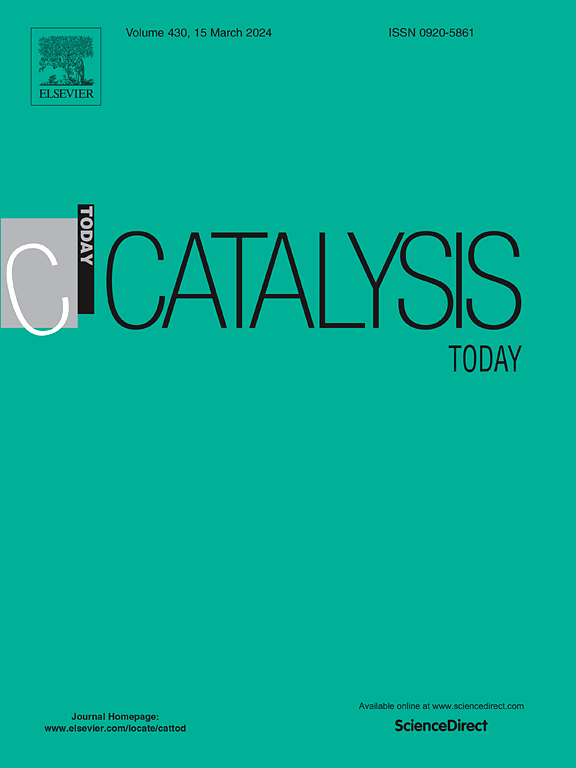探讨碱性化合物对5-羟甲基糠醛氧化分离制备2,5-呋喃二羧酸的影响
IF 5.2
2区 化学
Q1 CHEMISTRY, APPLIED
引用次数: 0
摘要
5-羟甲基糠醛(HMF)转化为有价值的化学品是生物质增值的关键挑战。这项研究探索了在不使用催化剂的情况下,在各种碱性化合物(KOH, NaOH, Na2CO₃和NaHCO3)的存在下HMF的降解。实验表明,即使在冷藏条件下,KOH和NaOH等强碱也能显著加速HMF的降解,而Na2CO3和NaHCO3等弱碱的降解速度较慢。此外,在不同碱性条件下,采用Pt-Bi/C催化剂对HMF的好氧氧化制2,5-呋喃二羧酸(FDCA)进行了评价。结果表明,碱性化合物的种类和强度对FDCA收率影响较大,以Na2CO3等中间碱的收率最高,可达99.3% %。该研究还检查了反应后碱性化合物的添加,揭示了这一步骤对于溶解FDCA是必不可少的,FDCA可能在酸性条件下以固体形式沉淀。考察了盐酸沉淀法和异丙醇溶出法两种分离回收FDCA的方法。这两种方法都被证明是有效的,HCl方法产生结晶FDCA和异丙醇提供了一种更环保的替代方法。这些发现为优化HMF活化的反应条件和改进FDCA回收工艺提供了有价值的见解。本文章由计算机程序翻译,如有差异,请以英文原文为准。
Addressing the influence of alkaline compounds in 5-hydroxymethylfurfural oxidation and separation towards 2,5-furandicarboxylic acid
The conversion of 5-hydroxymethylfurfural (HMF) into valuable chemicals is a critical challenge in biomass valorization. This study explores the degradation of HMF in the presence of various alkaline compounds (KOH, NaOH, Na2CO₃, and NaHCO3) without the use of a catalyst. The experiments showed that strong bases such as KOH and NaOH significantly accelerated HMF degradation, even under cold storage conditions, while weaker bases (Na2CO3 and NaHCO3) exhibited slower degradation rates. Additionally, the aerobic oxidation of HMF to 2,5-furandicarboxylic acid (FDCA) was evaluated using a Pt-Bi/C catalyst under different alkaline conditions. Results indicated that the type and strength of the alkaline compound strongly influenced FDCA yield, with intermediate bases such as Na2CO3 providing the highest yields (up to 99.3 %). The study also examined the post-reaction addition of alkaline compounds, revealing that this step is essential for dissolving FDCA, which may precipitate as a solid under acidic conditions. Two methods for FDCA separation and recovery were assessed: precipitation with HCl and dissolution in isopropanol. Both methods proved effective, with the HCl method yielding crystalline FDCA and isopropanol offering a more environmentally friendly alternative. These findings provide valuable insights into optimising reaction conditions for HMF valorization and improving FDCA recovery processes.
求助全文
通过发布文献求助,成功后即可免费获取论文全文。
去求助
来源期刊

Catalysis Today
化学-工程:化工
CiteScore
11.50
自引率
3.80%
发文量
573
审稿时长
2.9 months
期刊介绍:
Catalysis Today focuses on the rapid publication of original invited papers devoted to currently important topics in catalysis and related subjects. The journal only publishes special issues (Proposing a Catalysis Today Special Issue), each of which is supervised by Guest Editors who recruit individual papers and oversee the peer review process. Catalysis Today offers researchers in the field of catalysis in-depth overviews of topical issues.
Both fundamental and applied aspects of catalysis are covered. Subjects such as catalysis of immobilized organometallic and biocatalytic systems are welcome. Subjects related to catalysis such as experimental techniques, adsorption, process technology, synthesis, in situ characterization, computational, theoretical modeling, imaging and others are included if there is a clear relationship to catalysis.
 求助内容:
求助内容: 应助结果提醒方式:
应助结果提醒方式:


